
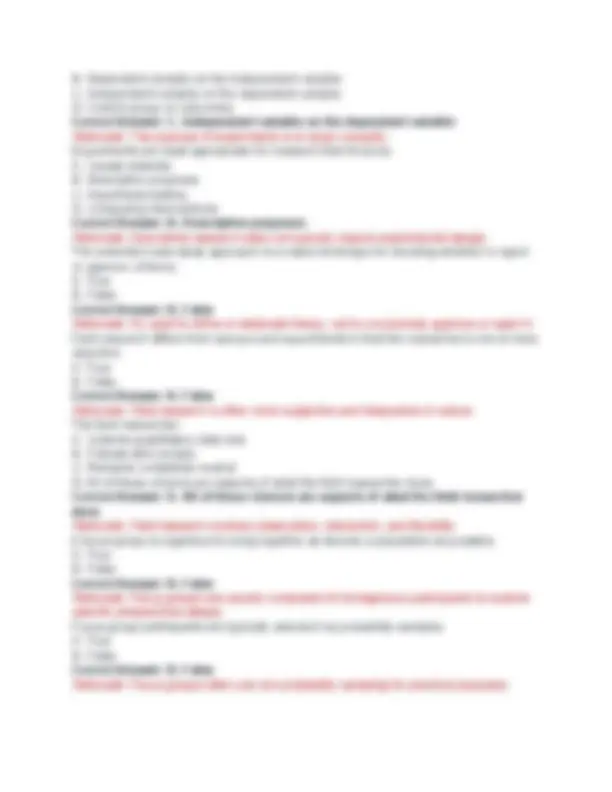
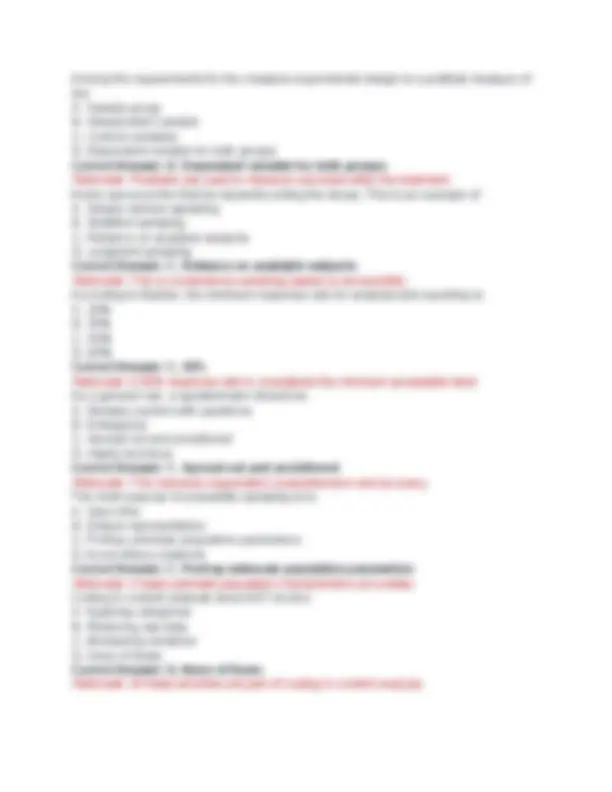
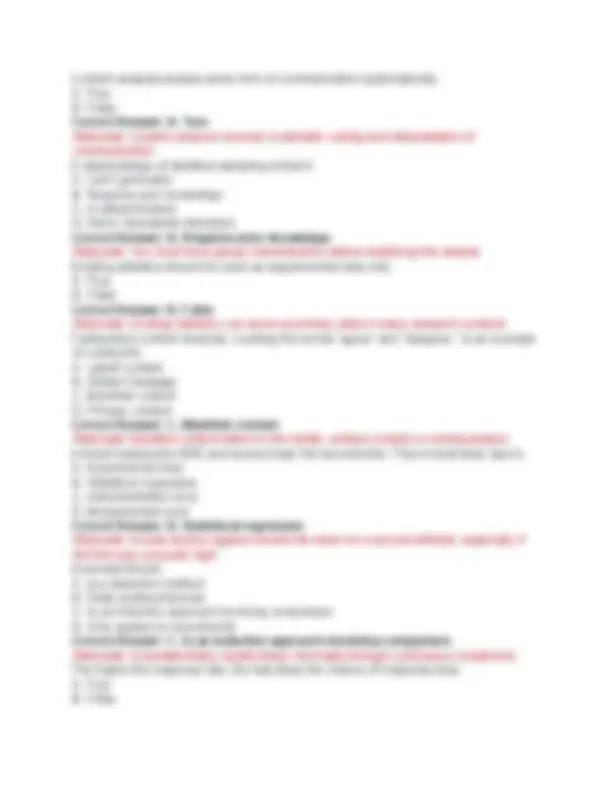
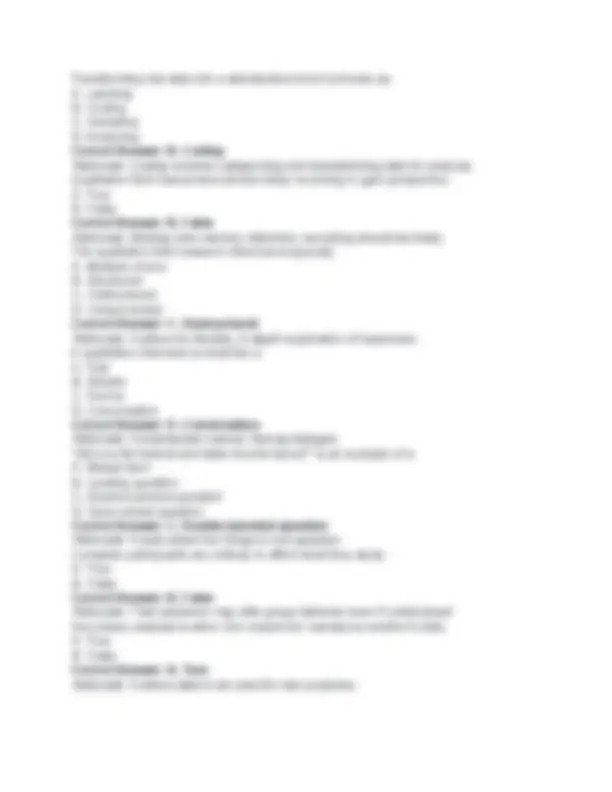
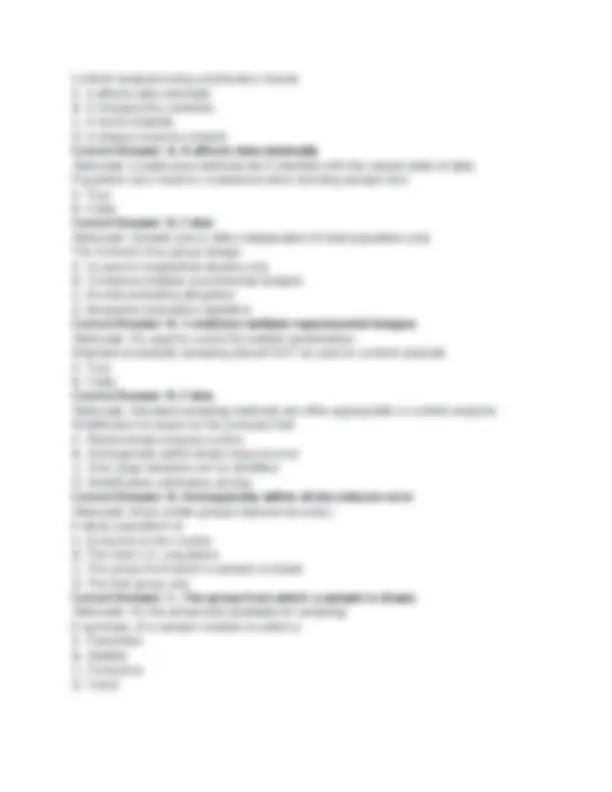
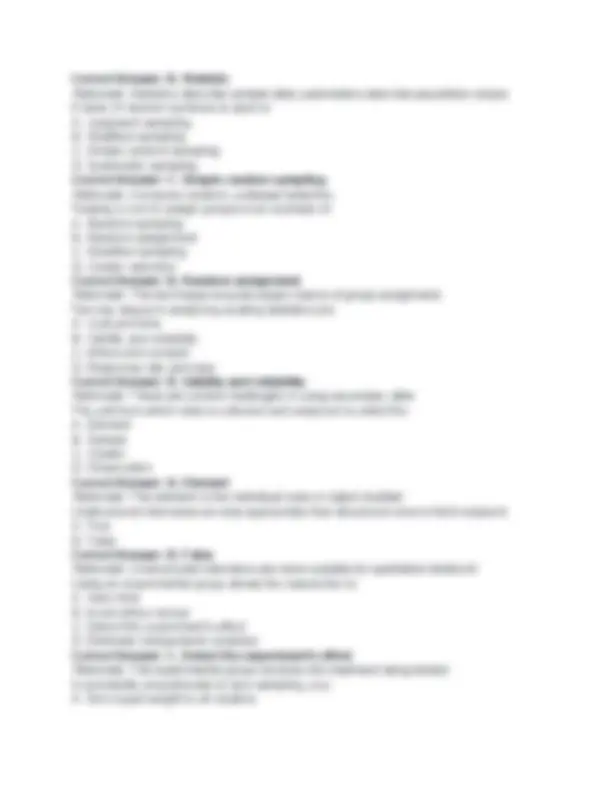
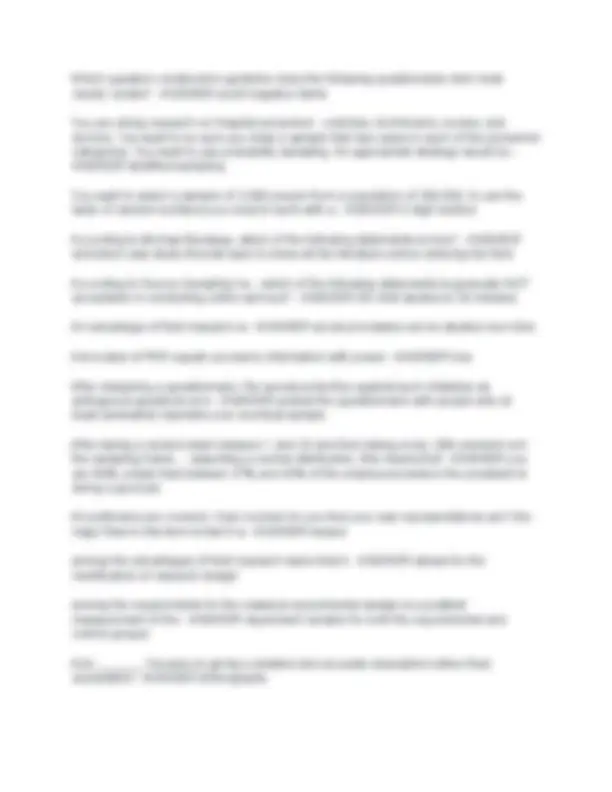
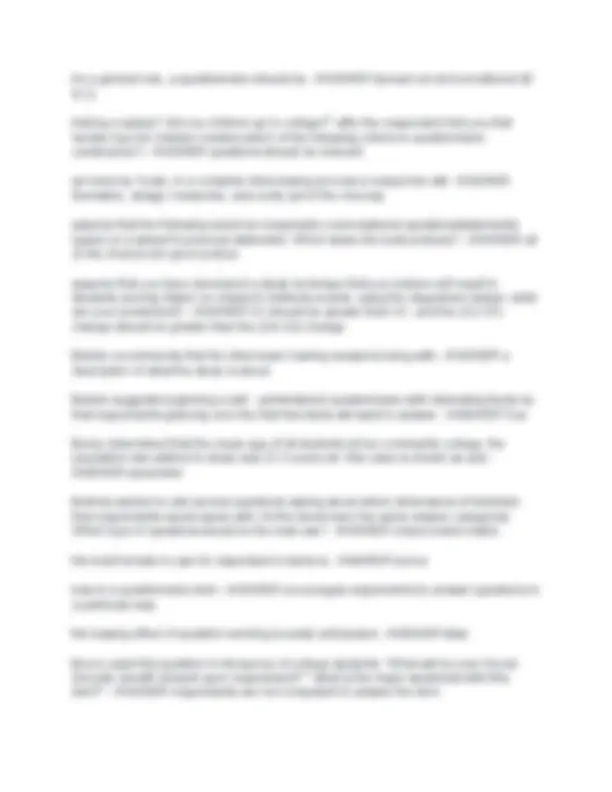
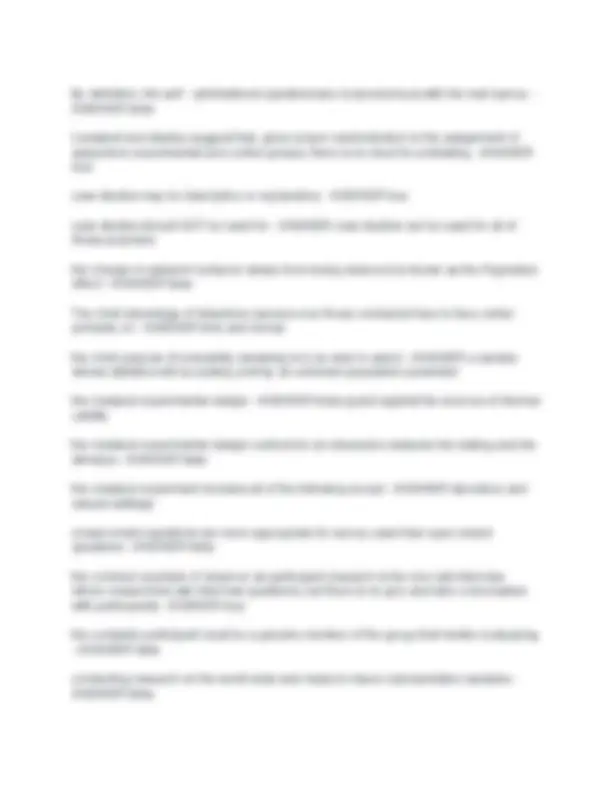
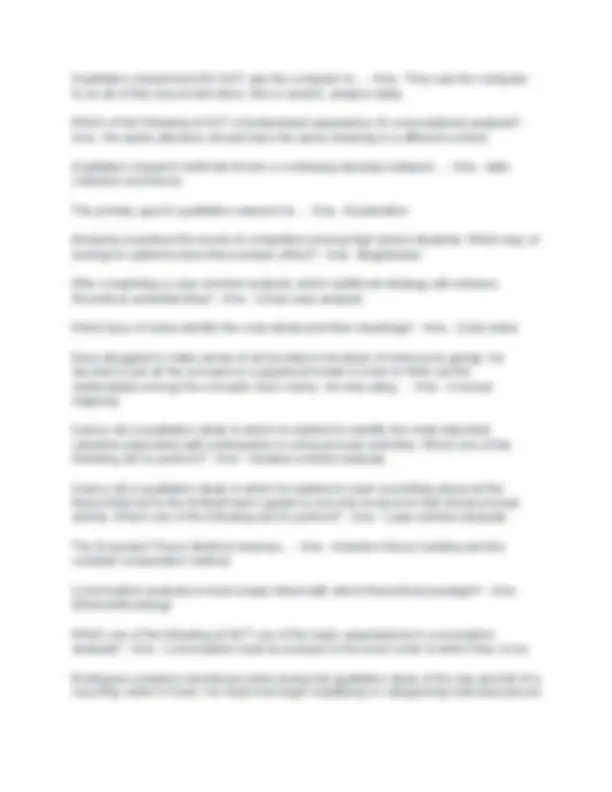
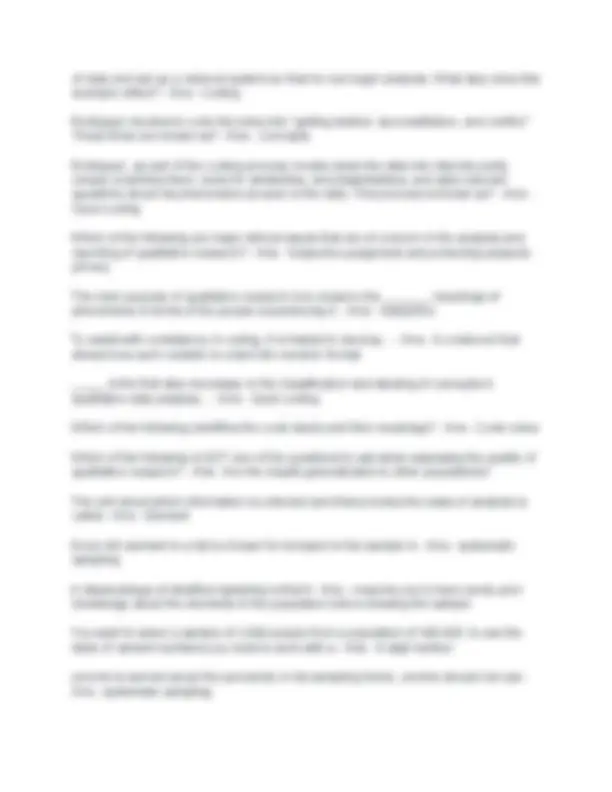
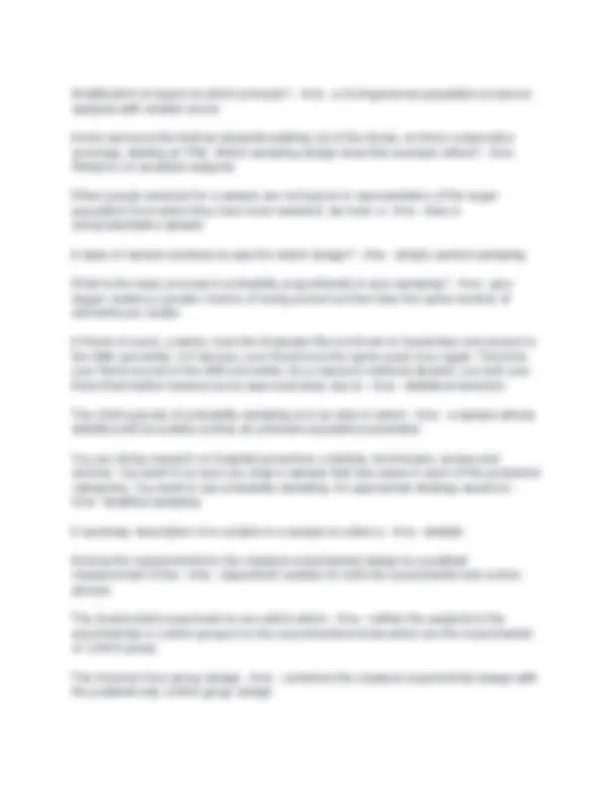
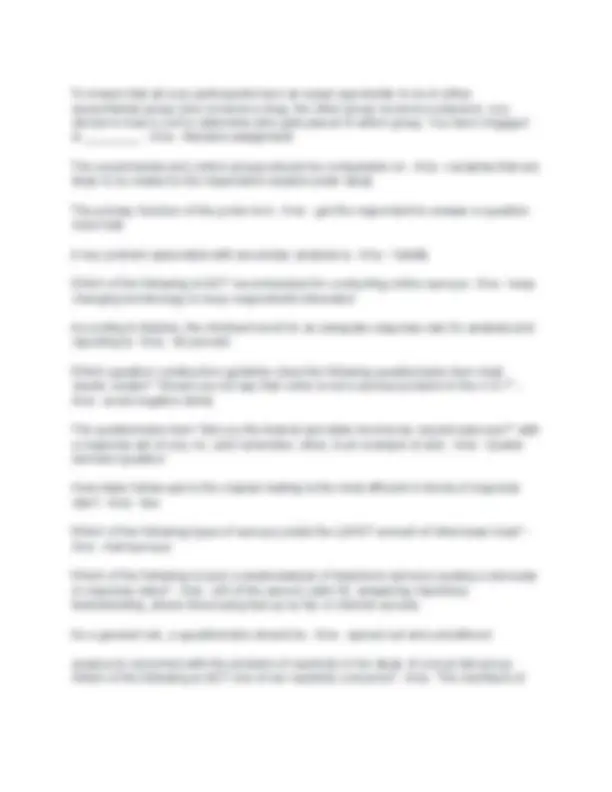

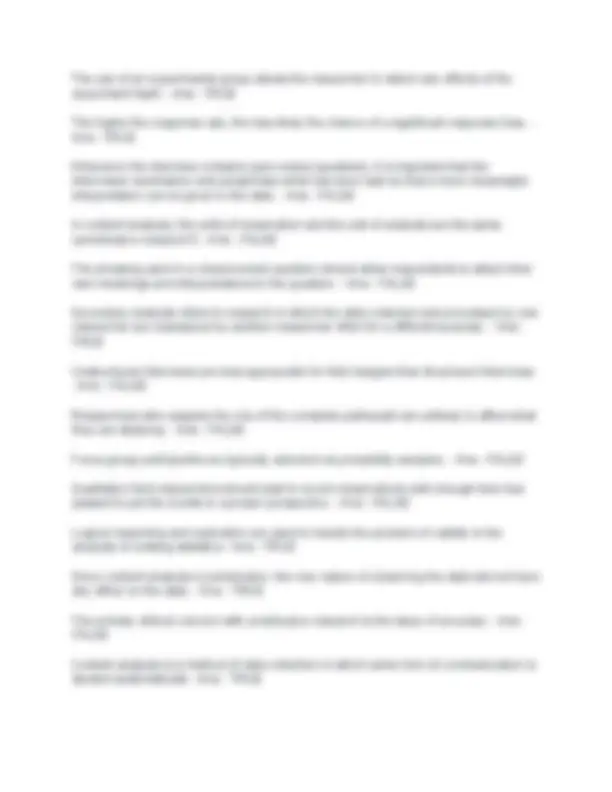
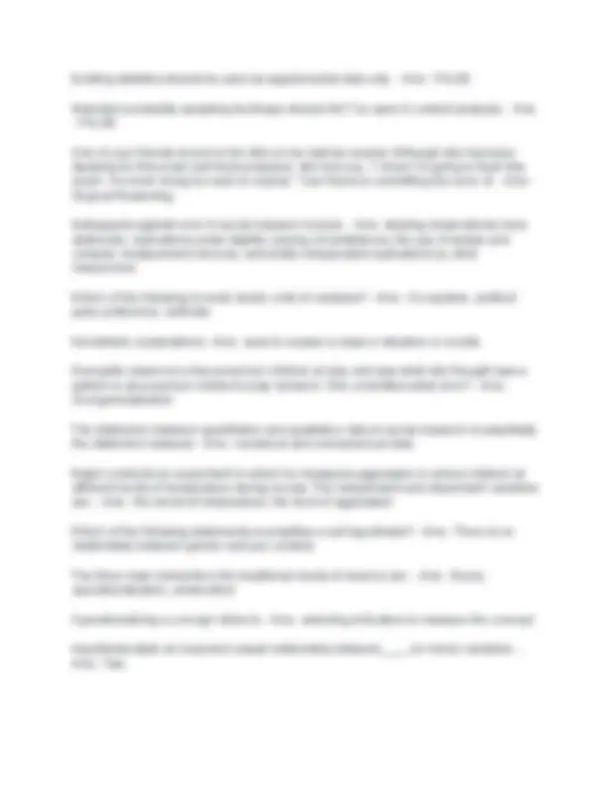
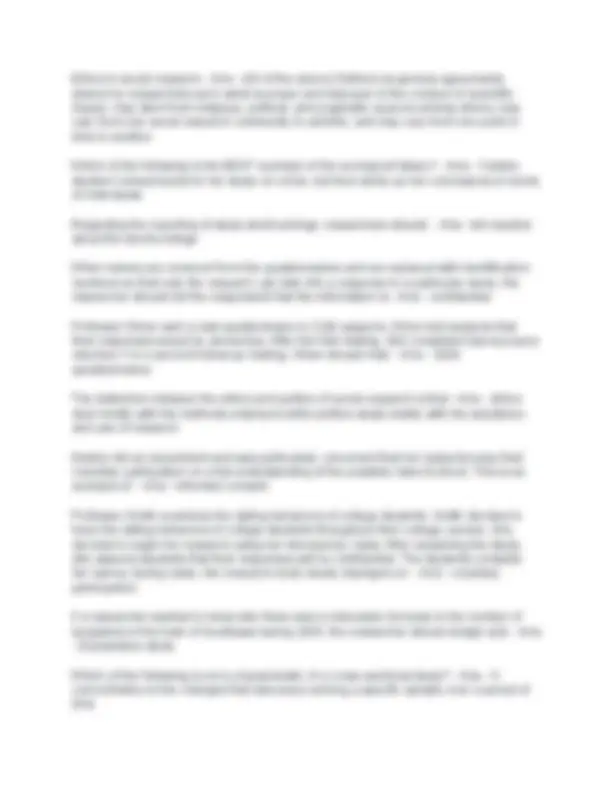
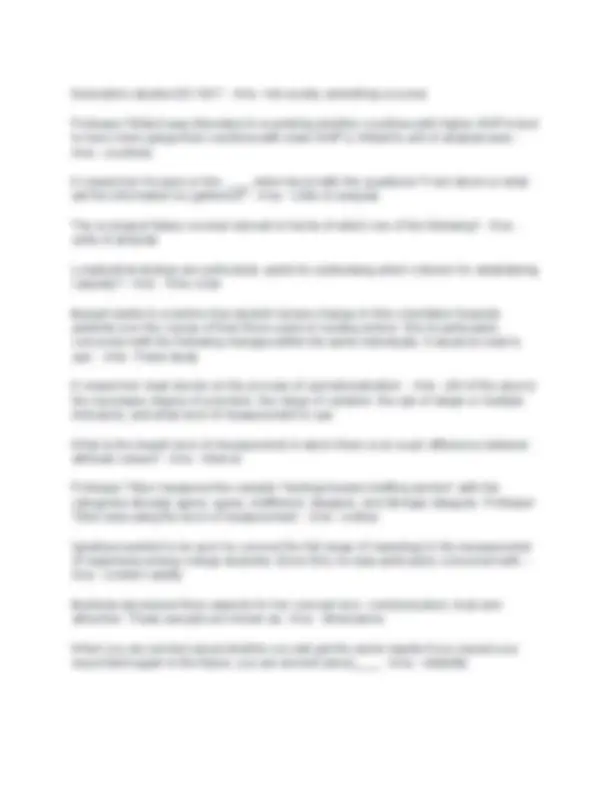
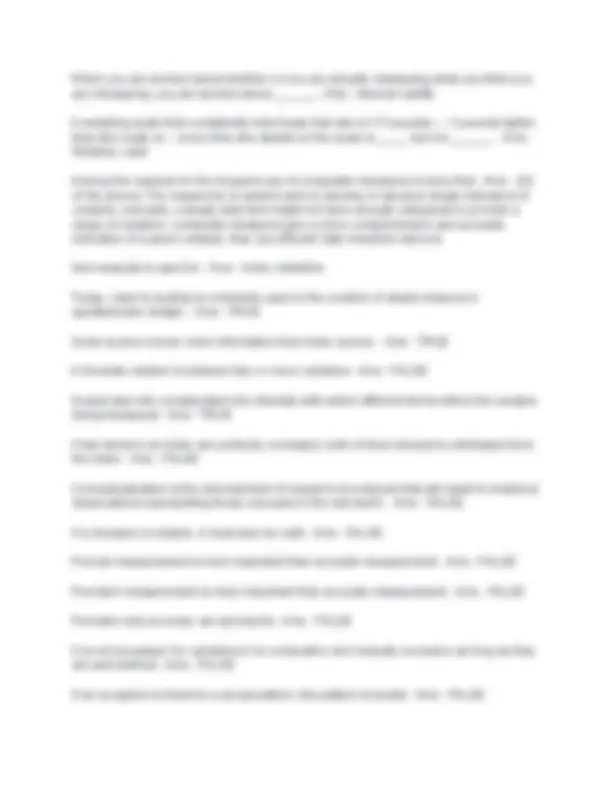
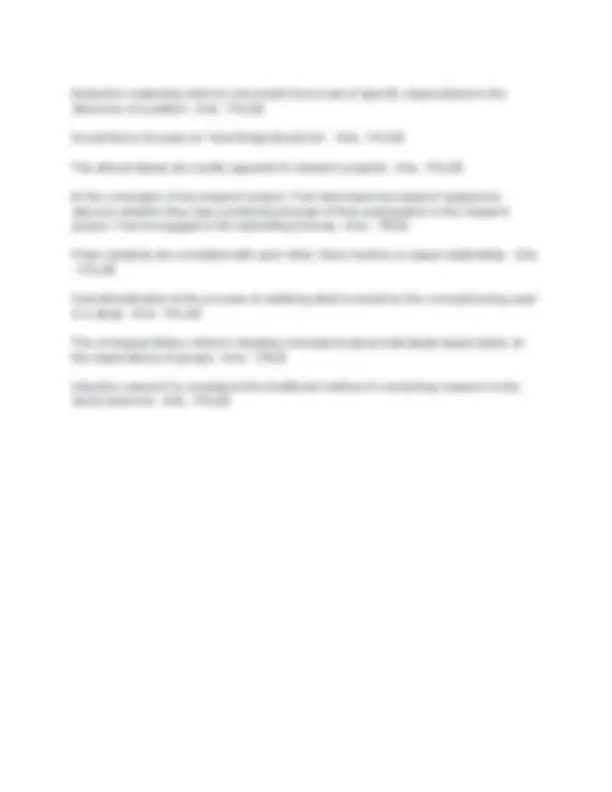


Study with the several resources on Docsity

Earn points by helping other students or get them with a premium plan


Prepare for your exams
Study with the several resources on Docsity

Earn points to download
Earn points by helping other students or get them with a premium plan
Community
Ask the community for help and clear up your study doubts
Discover the best universities in your country according to Docsity users
Free resources
Download our free guides on studying techniques, anxiety management strategies, and thesis advice from Docsity tutors
The double-blind experiment attempts to guard against experimenter bias. A. False B. True Correct Answer: B. True Rationale: Double-blind experiments prevent both participant and experimenter bias by ensuring neither knows group assignments. The double-blind experiment is one in which: A. The experimenter knows but the subjects do not B. The subjects know but the experimenter does not C. Only the control group is unaware D. Neither the subjects nor experimenters know group assignments Correct Answer: D. Neither the subjects nor experimenters know group assignments Rationale: This minimizes both subject and researcher bias. Drawing a judgment sample: A. Ensures randomness B. Allows researchers to use their expertise C. Always represents the population D. Avoids bias completely Correct Answer: B. Allows researchers to use their expertise Rationale: Judgment sampling relies on the researcher’s knowledge to select representative samples.
Typology: Exams
1 / 28

This page cannot be seen from the preview
Don't miss anything!





















The double-blind experiment attempts to guard against experimenter bias. A. False B. True Correct Answer: B. True Rationale: Double-blind experiments prevent both participant and experimenter bias by ensuring neither knows group assignments. The double-blind experiment is one in which: A. The experimenter knows but the subjects do not B. The subjects know but the experimenter does not C. Only the control group is unaware D. Neither the subjects nor experimenters know group assignments Correct Answer: D. Neither the subjects nor experimenters know group assignments Rationale: This minimizes both subject and researcher bias. Drawing a judgment sample: A. Ensures randomness B. Allows researchers to use their expertise C. Always represents the population D. Avoids bias completely Correct Answer: B. Allows researchers to use their expertise Rationale: Judgment sampling relies on the researcher’s knowledge to select representative samples. The ease of true experimentation is affected by the number of subjects involved. A. False B. True Correct Answer: B. True Rationale: A larger sample generally improves the feasibility and reliability of an experiment. EPSEM means: A. Equal placement in measurement B. Equal participation in study modules C. Equal probability of selection D. Empirical probability sample Correct Answer: C. Equal probability of selection Rationale: EPSEM stands for "Equal Probability of Selection Method."
The estimated probability that a population parameter lies within a given confidence interval is known as the confidence interval. A. True B. False Correct Answer: B. False Rationale: That definition refers to confidence level, not confidence interval. Ethical issues involving deception pertain particularly to: A. Case studies B. Surveys C. The complete participant role D. Laboratory experiments Correct Answer: C. The complete participant role Rationale: Complete participants conceal their identity, raising ethical concerns about deception. Every kth element in a list is chosen for inclusion in: A. Cluster sampling B. Systematic sampling C. Stratified sampling D. Random sampling Correct Answer: B. Systematic sampling Rationale: Systematic sampling selects every kth item from a list. An example of the complete participant role is: A. Mailing surveys anonymously B. Observing a group openly C. Joining a fraternity to study rituals without revealing researcher identity D. Interviewing without notes Correct Answer: C. Joining a fraternity to study rituals without revealing researcher identity Rationale: This is a covert research role typical of a complete participant. The experimental and control groups should be comparable on: A. The same sample size B. Age and gender only C. Variables likely related to the dependent variable D. Independent variables only Correct Answer: C. Variables likely related to the dependent variable Rationale: This ensures that observed effects can be attributed to the independent variable. Experimental mortality effects only need to be controlled when researching the elderly. A. True B. False Correct Answer: B. False Rationale: Mortality can affect any population and may bias results if not controlled. An experiment examines the effect of the: A. Sample size on the dependent variable
Among the requirements for the classical experimental design is a posttest measure of the: A. Sample group B. Independent variable C. Control variables D. Dependent variable for both groups Correct Answer: D. Dependent variable for both groups Rationale: Posttests are used to measure outcomes after the treatment. Andre surveyed the first ten students exiting the library. This is an example of: A. Simple random sampling B. Stratified sampling C. Reliance on available subjects D. Judgment sampling Correct Answer: C. Reliance on available subjects Rationale: This is convenience sampling based on accessibility. According to Babbie, the minimum response rate for analysis and reporting is: A. 20% B. 35% C. 50% D. 80% Correct Answer: C. 50% Rationale: A 50% response rate is considered the minimum acceptable level. As a general rule, a questionnaire should be: A. Densely packed with questions B. Ambiguous C. Spread out and uncluttered D. Highly technical Correct Answer: C. Spread out and uncluttered Rationale: This improves respondent comprehension and accuracy. The chief purpose of probability sampling is to: A. Save time B. Ensure representation C. Portray unknown population parameters D. Avoid ethics violations Correct Answer: C. Portray unknown population parameters Rationale: It helps estimate population characteristics accurately. Coding in content analysis does NOT involve: A. Applying categories B. Reducing raw data C. Measuring variables D. None of these Correct Answer: D. None of these Rationale: All listed activities are part of coding in content analysis.
Content analysis studies some form of communication systematically. A. True B. False Correct Answer: A. True Rationale: Content analysis involves systematic coding and interpretation of communication. A disadvantage of stratified sampling is that it: A. Can’t generalize B. Requires prior knowledge C. Is always biased D. Never represents minorities Correct Answer: B. Requires prior knowledge Rationale: You must know group characteristics before stratifying the sample. Existing statistics should be used as supplemental data only. A. True B. False Correct Answer: B. False Rationale: Existing statistics can serve as primary data in many research contexts Fantanella’s content analysis, counting the words “agree” and “disagree,” is an example of coding the: A. Latent content B. Hidden message C. Manifest content D. Primary content Correct Answer: C. Manifest content Rationale: Manifest content refers to the visible, surface content in communication. A friend retakes the GRE and scores lower the second time. This is most likely due to: A. Experimental bias B. Statistical regression C. Instrumentation error D. Measurement error Correct Answer: B. Statistical regression Rationale: Scores tend to regress toward the mean on a second attempt, especially if the first was unusually high. Grounded theory: A. Is a deductive method B. Tests existing theories C. Is an inductive approach involving comparison D. Only applies to experiments Correct Answer: C. Is an inductive approach involving comparison Rationale: Grounded theory builds theory from data through continuous comparison. The higher the response rate, the less likely the chance of response bias. A. True B. False
Correct Answer: C. Systematic sampling Rationale: Periodicity can bias systematic sampling if it aligns with the sampling interval. Jessica's reactivity concern should NOT include: A. Members acting differently due to observation B. Subjects changing behavior for social approval C. Members joining to lose weight D. Hawthorne effect Correct Answer: C. Members joining to lose weight Rationale: This is unrelated to researcher presence or observation. A key problem with secondary analysis is: A. Cost B. Time C. Validity D. Redundancy Correct Answer: C. Validity Rationale: Data may not perfectly match your research questions. Logical reasoning and replication help address: A. Sampling error B. Ethics C. Validity issues in existing statistics D. Double-blind conditions Correct Answer: C. Validity issues in existing statistics Rationale: These strategies strengthen inference accuracy in secondary data use. The phrasing in a closed-ended question should allow for subjective interpretation. A. True B. False Correct Answer: B. False Rationale: Closed-ended questions should be clear and uniform in meaning. The primary ethical concern in unobtrusive research is: A. Consent B. Accuracy C. Confidentiality D. Risk of harm Correct Answer: B. Accuracy Rationale: Ethical concerns relate more to truthful interpretation than to participant harm. The primary function of a probe is to: A. Redirect the interview B. Test reliability C. Encourage deeper responses D. End the interview Correct Answer: C. Encourage deeper responses Rationale: Probes help gather richer, more complete data.
Transforming raw data into a standardized form is known as: A. Labeling B. Coding C. Sampling D. Analyzing Correct Answer: B. Coding Rationale: Coding involves categorizing and standardizing data for analysis. Qualitative field researchers should delay recording to gain perspective. A. True B. False Correct Answer: B. False Rationale: Waiting risks memory distortion; recording should be timely. The qualitative field research interview is typically: A. Multiple-choice B. Structured C. Unstructured D. Closed-ended Correct Answer: C. Unstructured Rationale: It allows for flexible, in-depth exploration of responses. A qualitative interview is most like a: A. Test B. Debate C. Survey D. Conversation Correct Answer: D. Conversation Rationale: It emphasizes natural, flowing dialogue. "Did you file federal and state income taxes?" is an example of a: A. Biased item B. Leading question C. Double-barreled question D. Open-ended question Correct Answer: C. Double-barreled question Rationale: It asks about two things in one question. Complete participants are unlikely to affect what they study. A. True B. False Correct Answer: B. False Rationale: Their presence may alter group behavior even if undisclosed. Secondary analysis is when one researcher reanalyzes another's data. A. True B. False Correct Answer: A. True Rationale: It allows data to be used for new purposes.
Correct Answer: B. Statistic Rationale: Statistics describe sample data; parameters describe population values. A table of random numbers is used in: A. Judgment sampling B. Stratified sampling C. Simple random sampling D. Systematic sampling Correct Answer: C. Simple random sampling Rationale: It ensures random, unbiased selection. Tossing a coin to assign groups is an example of: A. Random sampling B. Random assignment C. Stratified sampling D. Cluster selection Correct Answer: B. Random assignment Rationale: This technique ensures equal chance of group assignment. Two key issues in analyzing existing statistics are: A. Cost and time B. Validity and reliability C. Ethics and consent D. Response rate and bias Correct Answer: B. Validity and reliability Rationale: These are central challenges in using secondary data. The unit from which data is collected and analyzed is called the: A. Element B. Sample C. Cluster D. Observation Correct Answer: A. Element Rationale: The element is the individual case or object studied. Unstructured interviews are less appropriate than structured ones in field research. A. True B. False Correct Answer: B. False Rationale: Unstructured interviews are more suitable for qualitative fieldwork. Using an experimental group allows the researcher to: A. Save time B. Avoid ethics review C. Detect the experiment's effect D. Eliminate independent variables Correct Answer: C. Detect the experiment's effect Rationale: The experimental group receives the treatment being tested. In probability proportionate to size sampling, you: A. Give equal weight to all clusters
B. Sample smaller clusters more C. Give larger clusters higher selection probability but sample equal elements D. Randomly ignore population size Correct Answer: C. Give larger clusters higher selection probability but sample equal elements Rationale: This balances representation and feasibility. When interviews include open-ended questions, interviewers should paraphrase responses. A. True B. False Correct Answer: B. False Rationale: Paraphrasing can introduce bias; responses should be recorded accurately Snowball sampling is particularly useful when studying: A. Large, general populations B. Randomized control groups C. Hard-to-reach or hidden populations D. Highly visible public figures Correct Answer: C. Hard-to-reach or hidden populations Rationale: Snowball sampling leverages participant referrals, ideal for accessing marginalized or elusive groups. What is the main goal of inferential statistics? A. To describe data B. To organize data into tables C. To draw conclusions about a population based on a sample D. To summarize numerical data visually Correct Answer: C. To draw conclusions about a population based on a sample Rationale: Inferential statistics allow generalization from sample data to larger populations. In a research study, the term "external validity" refers to: A. The extent to which the study design is valid B. The ability to generalize findings to other populations or settings C. The precision of measurement tools D. The presence of confounding variables Correct Answer: B. The ability to generalize findings to other populations or settings Rationale: External validity assesses the generalizability of study outcomes beyond the specific context. Which of the following is a qualitative data collection method? A. Structured survey B. Content analysis of census reports C. Focus group discussion D. Standardized test scores Correct Answer: C. Focus group discussion Rationale: Focus groups are open-ended and exploratory, characteristic of qualitative research. Which type of validity is concerned with whether a test appears to measure what it's supposed to? A. Construct validity B. Criterion validity C. Content validity D. Face validity Correct Answer: D. Face validity Rationale: Face validity is the most superficial form, based on appearance rather than statistical testing. A major strength of experiments is their: A. High external validity B. Ability to establish causality C. Ability to study large populations D. Use of natural settings Correct
Which question construction guideline does the following questionnaire item most clearly violate? - ANSWER avoid negative items You are doing research on hospital personnel - orderlies, technicians, nurses, and doctors. You want to be sure you draw a sample that has cases in each of the personnel categories. You want to use probability sampling. An appropriate strategy would be - ANSWER stratified sampling You want to select a sample of 3,000 people from a population of 300,000, to use the table of random numbers you need to work with a - ANSWER 6 digit number According to Michael Buraway, which of the following statements is true? - ANSWER extended case study theorist seek to know all the literature before entering the field According to Survey Sampling Inc., which of the following statements is generally NOT acceptable in conducting online surveys? - ANSWER DO limit studies to 30 minutes An advantage of field research is - ANSWER social processes can be studied over time Advocates of PAR equate access to information with power - ANSWER true After designing a questionnaire, the surest protection against such mistakes as ambiguous questions is to - ANSWER pretest the questionnaire with people who at least somewhat resemble your eventual sample After taking a random start between 1 and 20 and then taking every 20th element rom the sampling frame.... assuming a normal distribution, this means that - ANSWER you are 68% certain that between 37% and 43% of the employees believe the president is doing a good job All politicians are crooked. How crooked do you feel your own representatives are? the major flaw in this item is that it is - ANSWER biased among the advantages of field research is/are that it - ANSWER allows for the modification of research design among the requirements for the classical experimental design is a posttest measurement of the - ANSWER dependent variable for both the experimental and control groups A(n) _______ focuses on giving a detailed and accurate description rather than explanation - ANSWER Ethnography
As a general rule, a questionnaire should be - ANSWER Spread out and uncluttered (B & C) Asking a subject "did you children go to college?" after the respondent told you that he/she has not children violates which of the following criteria in questionnaire construction? - ANSWER questions should be relevant as noted by Kyale, in a complete interviewing process a researcher will - ANSWER thematize, design, transcribe, and verify (all of the choices) assume that the following would be reasonable conversational questions/statements based on a subject's previous statement. Which is/are the best probe(s)? - ANSWER all of the choices are good probes assume that you have developed a study technique that you believe will result in students scoring higher on research methods exams. using the diagramed design, what are your predictions? - ANSWER O2 should be greater than O1, and the (O2-O1) change should be greater than the (O4-O3) change Babbie recommends that the interviewer training sessions being with - ANSWER a description of what the study is about Babbie suggests beginning a self - administered questionnaire with interesting items so that respondents glancing over the first few items will want to answer - ANSWER True Becky determined that the mean age of all students at her community college, the population she wished to study was 22.3 years old. this value is known as a(n) - ANSWER parameter Belinda wanted to ask several questions asking about which dimensions of feminism that respondents would agree with. All the items have the same answer categories. Which type of questions would be the best use? - ANSWER closed ended matrix the best formate to use for responses to items is - ANSWER boxes bias in a questionnaire item - ANSWER encourages respondents to answer questions in a particular way the biasing effect of question wording is easily anticipated - ANSWER false Boyce used this question in his survey of college students: "What will be your Social Security benefit amount upon requirement?" "what is the major weakness with this item?" - ANSWER respondents are not competent to answer the item
a confidence interval at the 68% confidence level will be larger than one constructed at the 95% confidence level - ANSWER false a demonstrated lack of response bias is more important than a high response rate - ANSWER true the design diagramed the prior question - ANSWER is the classical experimental design the design used in the prior question is a - ANSWER one group, pre test, post test design Which of the following statements is True about variable-oriented analysis? - Ans - It provides a partial overall explanation using a relatively few number of variables. Which of the following statements about the grounded theory method is TRUE? - Ans - It is similar to cross-case analysis. Qualitative analysis is easily taught as a series of rote procedures. - Ans - false Data collection, analysis and theory are more intimately intertwined in qualitative analysis than in quantitative analysis. - Ans - t Qualitative research is undertaken for descriptive purposes, never for explanatory purposes. - Ans - F Variable-oriented research is similar to the nomothetic model of explanation. - Ans - T The utility of case-oriented analysis is the fact that one case can make a theory. - Ans - F Conversational analysts look only at the the structure of communication. - Ans - F Qualitative data processing is both a science and an art. - Ans - T Open coding refers to the initial classification and labeling of concepts. - Ans - T Concept mapping is appropriate for both qualitative and quantitative analysis. - Ans - T The search for the intentional or unintentional meanings attached to signs is called semiotics. - Ans - T The concept is the organizing principle for qualitative coding. - Ans - T
Qualitative analysis requires the conversion of social research data into a numerical format. - Ans - F Judging the quality of qualitative research is easier than judging the quality of quantitative research. - Ans - F Case-oriented analysis is more valuable in qualitative research than variable-oriented research. - Ans - F It is nearly impossible to use any statistical analysis if you have collected qualitative data. - Ans - F Memoing provides the researchers with structured ways to examine the data and the coded text. - Ans - T The grounded theory method begins with... - Ans - Observations Semiotics is a social science because... - Ans - We have agreements about the meanings associated with particular signs. qualitative research may be undertaken for... - Ans - Descriptive purposes, the construction of an ethnography, and/or explanatory purposes. Which of the following is NOT one of the four stages of the constant comparative method? - Ans - All of these choices are stages in the constant comparative method (comparing incidents, integrating categories, delimiting the theory, writing theory) Which of the following statements are FALSE regarding semiotic analysis? - Ans - Language is the only sign system of interest to those doing semiotic analysis. Code notes... - Ans - Identify the code labels and their meanings. Which of these concept mapping statements are TRUE? - Ans - Concept mapping can be used for either quantitative or qualitative analysis. Which of the following is NOT a sign system used in semiotic analysis? - Ans - All of these are sign systems (langauge, music, math, etiquette) In reading court decisions, Professor Wofford notices decisions typically discuss the "rational male." Wofford begins to write notes in which she ruminates about the notion of the rational male as well as why the concept of the rational female is not mentioned. Woffords memos are... - Ans - Theoretical notes
of data and set up a retrieval system so that he can begin analysis. What step does this example reflect? - Ans - Coding Rodriguez decides to code his notes into "getting started, success/failure, and conflict." These three are known as? - Ans - Concepts Rodriguez, as part of the coding process, breaks down the data into discrete parts, closely examines them, looks for similarities, and dissimilarities, and asks relevant questions about his phenomena as seen in the data. This process is known as? - Ans - Open coding Which of the following are major ethical issues that are of concern in the analysis and reporting of qualitative research? - Ans - Subjective judgement and protecting subjects privacy The main purpose of qualitative research is to observe the _______ meanings of phenomena in terms of the people experiencing it. - Ans - Subjective To assist with consistency in coding, it is helpful to develop... - Ans - A codebook that shows how each variable is coded into numeric format. _____ is the first step necessary in the classification and labeling of concepts in qualitative data analysis... - Ans - Open coding Which of the following identifies the code labels and their meanings? - Ans - Code notes Which of the following is NOT one of the questions to ask when assessing the quality of qualitative research? - Ans - Are the results generalizable to other populations? The unit about which information is collected and that provides the basis of analysis is called - Ans - Element Every kth element in a list is chosen for inclusion in the sample in - Ans - systematic sampling A disadvantage of stratified sampling is that it - Ans - requires you to have some prior knowledge about the elements in the population before drawing the sample You want to select a sample of 3,000 people from a population of 300,000. to use the table of random numbers you need to work with a - Ans - 6 - digit number Jerome is worried about the periodicity in his sampling frame. Jerome should not use - Ans - systematic sampling
Stratification is based on which principle? - Ans - a homogeneous population produces samples with smaller errors Andre surveyed the first ten students walking out of the library on three consecutive evenings, starting at 7PM. Which sampling design does this example reflect? - Ans - Reliance on available subjects When people selected for a sample are not typical or representative of the larger population from which they have been selected, we have a - Ans - bias or unrepresentative sample A table of random numbers is used for which design? - Ans - simple random sampling What is the basic process in probability proportionate to size sampling? - Ans - give bigger clusters a greater chance of being picked but then take the same number of elements per cluster A friend of yours, a senior, took the Graduate Record Exam in September and scored in the 99th percentile. In February, your friend took the same exam over again. This time your friend scored in the 84th percentile. As a research methods student, you told your friend that his/her lowered score was most likely due to - Ans - statistical selection The chief purpose of probability sampling is to be able to select - Ans - a sample whose statistics will accurately portray an unknown population parameter You are doing research on hospital personnel--orderlies, technicians, nurses and doctors. You want to be sure you draw a sample that has cases in each of the personnel categories. You want to use probability sampling. An appropriate strategy would be - Ans - stratified sampling A summary description of a variable in a sample is called a - Ans - statistic Among the requirements for the classical experimental design is a posttest measurement of the - Ans - dependent variable for both the experimental and control groups The double-blind experiment is one which which - Ans - neither the subjects in the experimental or control groups nor the experimenters know which are the experimental or control group. The Solomon four-group design - Ans - combines the classical experimental design with the posttest-only control group design